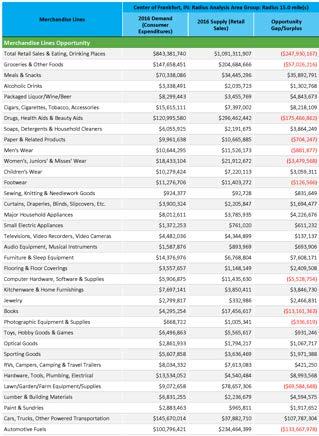
2 minute read
CLINTON COUNTY COMMUNITY FOUNDATION
by REA site
http://www.cfclinton.org/index.html
The Clinton County Community Foundation’s mission is to improve the quality of life in the community through the accumulation and stewardship of enduring charitable gifts. Grants are awarded to fund projects for which there is a demonstrable community benefit in one of the following areas of interest:
Advertisement
1. Cultural Affairs -- to include the support of programs and facilities which are designed to establish a diversified county cultural program that offers widespread participation and appreciation;
2. Civic Affairs -- to include support of programs related to criminal justice, community development, employment, citizen involvement, leadership training, and other general community activities;
3. Community Beautification -- to include the support of projects that advocate, stimulate and support community vitality, beautification/environmental preservation and adornment.
APPENDIX C:
ANATOMY OF A HISTORIC ‘MAIN STREET’ BUILDING
APPENDIX D: DESIGN/INFRASTRUCTURE UNIT PRICE COSTS/BUDGETING NUMBERS
Concrete Curb $25.00/ft.
Painted Striping $1.00/sq. ft.
Limestone $175.00/cu. ft. Granite $250.00/cu. ft. Electrical Point of Service $10,000.00/ea
Site Lights $8,000.00/ea Traffic Signalization $120,000.00/ea. Traffic Signalization $80,000.00/ea. Wayfinding/Interpretive to $500,000/ ea (based on previously constructed gateways in other communities)
*It should be noted that all costs listed above are installed costs and are based on 2016 bid prices. Regional markets, inflation, and other factors will influence pricing.
APPENDIX E:
GAP ANALYSIS RETAIL STORE & MERCHANDISE SPENDING
GAP ANALYSIS: RETAIL STORE AND MERCHANDISE SPENDING
To better understand the economy of Frankfort, the following analysis was conducted. The gap analysis of retail store and merchandise spending provide evidence of surplus in certain areas or opportunity gaps. The gap analysis was conducted on the retail trade area of consumers within 1, 10, and 15 miles of the town center. Consumers living within a 10 mile radius of town are consider the core consumers for Frankfort, while those within 15 miles are still likely to spend money in town.
The difference between local demand and supply provide the gap or surplus available for each category. The demand data is obtained from the Consumer Expenditure Survey (CE Survey or CEX) performed by the U.S. Bureau of Labor Statistics (BLS), and the supply data is obtained from the Census of Retail Trade (CRT) from the U.S. Census.
The retail gap analysis focuses on the money spent at each type of retail store, while the merchandise analysis uses money spent on types of merchandise, regardless of the type of store. The analysis will provide insight to opportunities to target underserved markets. The figures in red represent a surplus where Frankfort is supplying more than the local consumer demand. The figures in black represent an opportunity gap where the local supply is less than the demand for certain products or stores.
Retail Trade Area
Source: Nielsen Solution Center
APPENDIX E:
GAP ANALYSIS RETAIL STORE & MERCHANDISE SPENDING
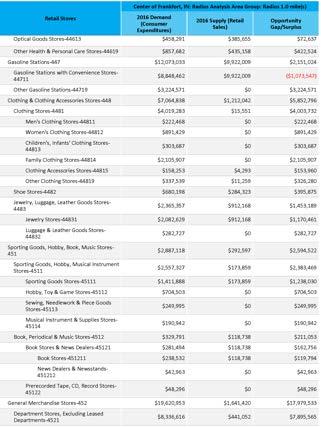
RETAIL STORE SPENDING WITHIN 1.0 MILE RADIUS

APPENDIX E:
GAP ANALYSIS RETAIL STORE & MERCHANDISE SPENDING

RETAIL STORE SPENDING WITHIN 10.0 MILE RADIUS

APPENDIX E:
GAP ANALYSIS RETAIL STORE & MERCHANDISE SPENDING
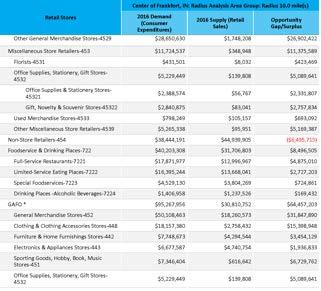

APPENDIX E:
GAP ANALYSIS RETAIL STORE & MERCHANDISE SPENDING
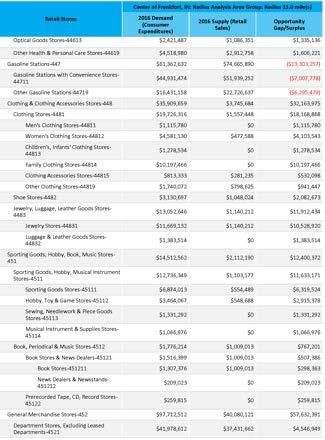
RETAIL STORE SPENDING WITHIN 15.0 MILE RADIUS
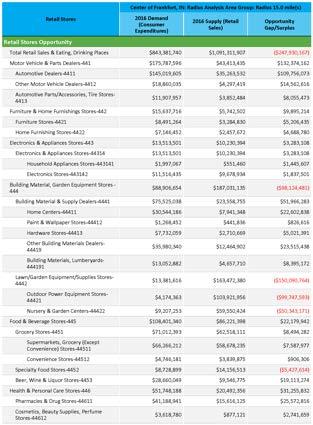
APPENDIX E:
GAP ANALYSIS RETAIL STORE & MERCHANDISE SPENDING

MERCHANDISE OPPORTUNITY WITHIN 1.0 MILE RADIUS

APPENDIX E:
GAP ANALYSIS RETAIL STORE & MERCHANDISE SPENDING

MERCHANDISE OPPORTUNITY WITHIN 10.0 MILE RADIUS
APPENDIX E:
GAP ANALYSIS RETAIL STORE & MERCHANDISE SPENDING
